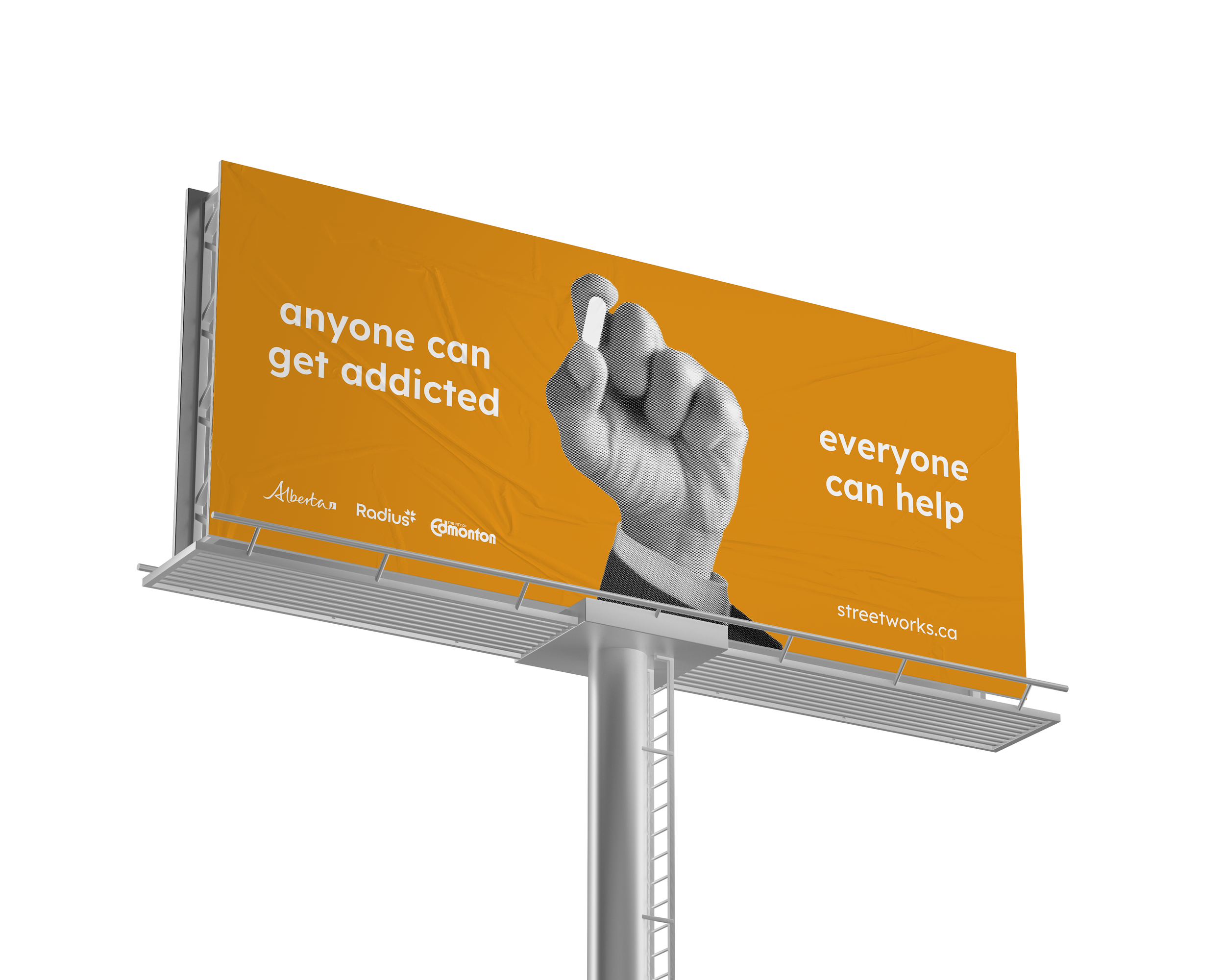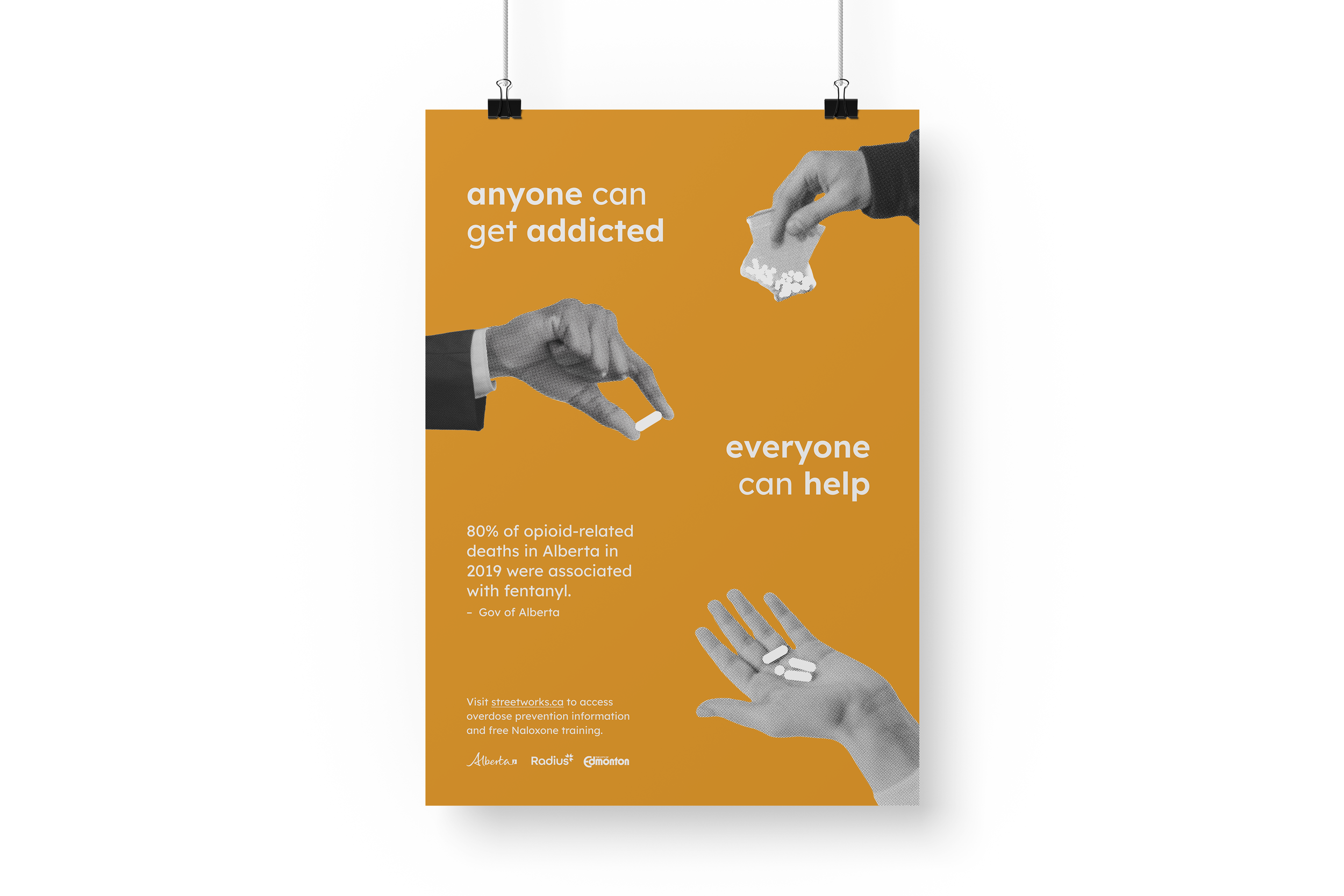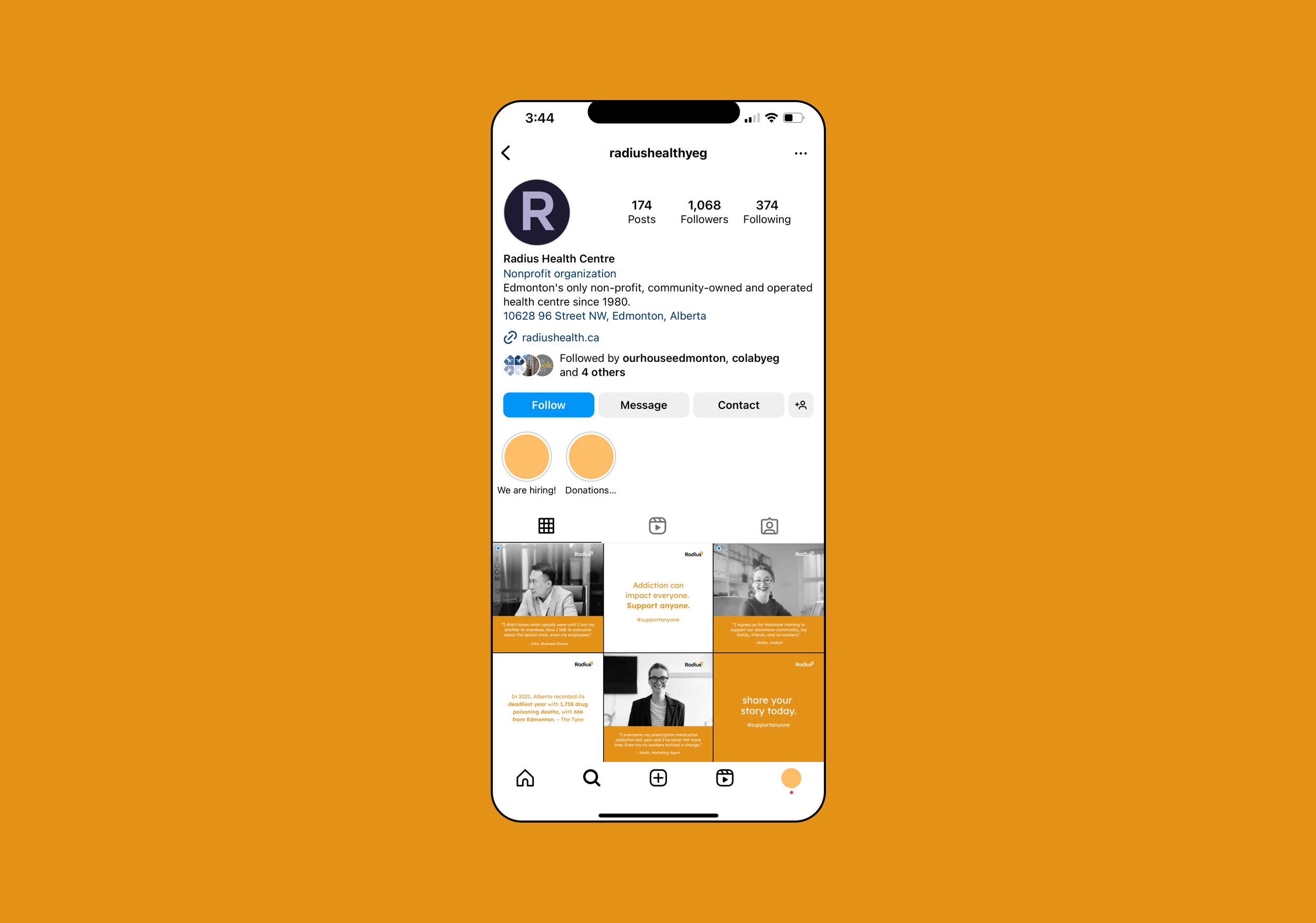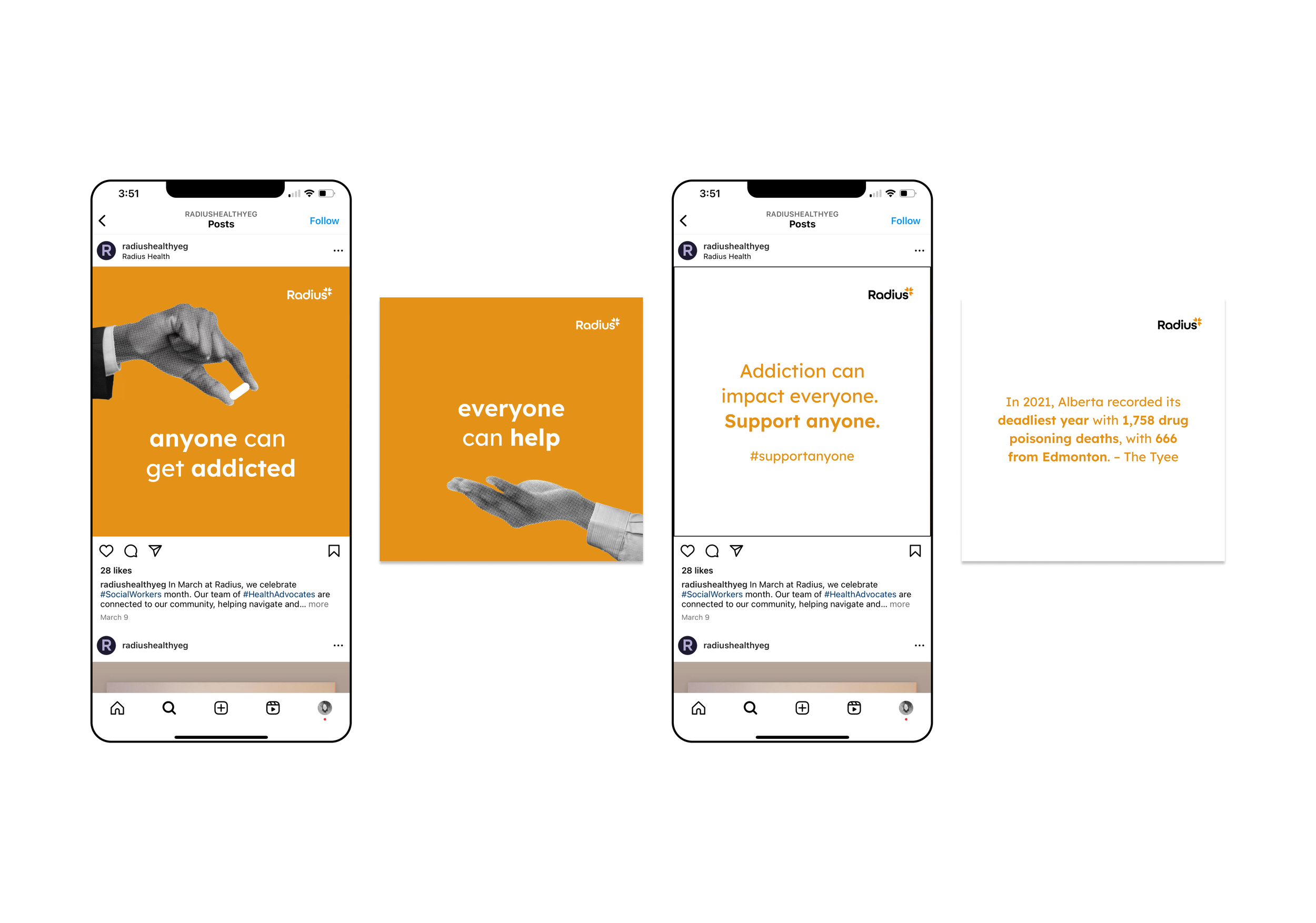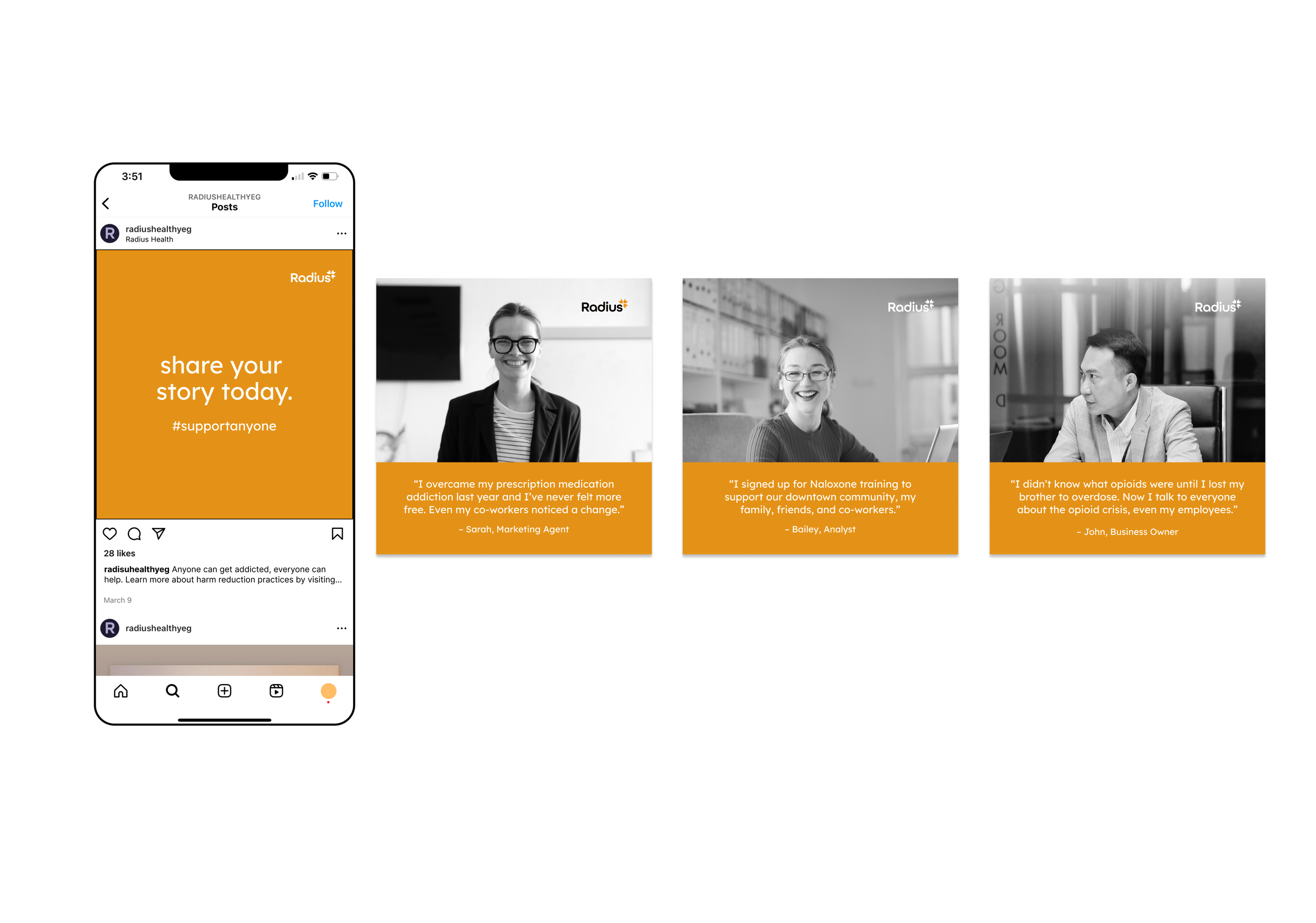Harm Reduction Campaign
Project Overview
This self-directed harm reduction campaign aims to inform everyday Edmontonians, especially those working in corporate environments, about the realities of the opioid crisis while promoting a compassionate approach to the individuals affected. The design features clear, engaging visuals that combine statistics and personal narratives to illustrate the impact of opioid use and the importance of harm reduction strategies.
Role
Designer
Project Date
February – May 2023
Client
Radius Health
Class Project
Involved
Campaign Design
Design Research
Information Design
Project Details
-
The project's goal was to examine social issues related to harm reduction and the opioid crisis in Edmonton's downtown area, especially among corporate workers. I collaborated with Radius Health, previously known as Boyle McCauley Health Centre, a local organization that emphasizes community outreach and public health, to develop a campaign that reduces the stigma around opioid addiction and raises awareness of existing educational resources.
-
I identified a user need while researching harm reduction initiatives in Edmonton. I noticed that existing campaigns mainly targeted opioid users, houseless communities, and individuals misusing prescription pain medications. Most advertisements relied on warning and fear-based messages to convey their points.
Recognizing a gap, I aimed to reach an audience that has often been overlooked—those who may feel disconnected from the opioid crisis due to their location, occupation, or personal relationships. To achieve this, I focused on creating strong, uplifting messages that highlight a community-based approach.
-
My research process for this project took on many forms. To gain a better understanding of the issue at hand, I made sure to gather information from both traditional and non-traditional sources. Notably, my process consisted of:
Naloxone training: This step was crucial in understanding some of the information available to the campaign's target audience. It allowed me to engage directly with the resources and gain insights into their messaging.
Researching global harm reduction campaigns: By examining a variety of harm reduction initiatives, I was able to identify effective strategies and common challenges faced in past campaigns. This comparative analysis provided valuable context for tailoring our approach.
Website Audit: This involved reviewing existing resources and materials on Government of Alberta websites who had a similar audience. Understanding what has been previously offered helped to identify gaps and opportunities to improve messaging.
Exploring design considerations for individuals with opioid addictions: I focused on how to effectively design materials by looking into the psychological impact of colors and imagery, ensuring that the communication is not only effective but also empathetic to the experiences of those affected.
This multi-faceted approach enriched my understanding of the issue and informed the development of the campaign moving forward.
-
I connected with Emily, a community support worker from Radius Health to answer some questions. Seeking her advice and her perspective, I was able to gather valuable insights into Edmonton's public health organizations and her experiences with the opioid crisis and harm reduction. Some highlights from our interview were:
“I am very much pro Naloxone, and would like everyone to have a kit. People think it is just for those who have addictions, but that isn't true.” – Emily
“It is not always easy to tell when someone is using substances, and we don't always know what someone is struggling with, and even if we do know, and the issue is not opioids often drug supplies are contaminated, and it is better to be prepared. No one needs to know you have a naloxone kit if you don't want them to know because they are free at pharmacies and emergency rooms and do not require identification.” – Emily
“Many people have not heard about harm reduction or if they have think it is only for drugs or sex work. In reality we all practice harm reduction every day. We get up and brush our teeth, which reduces harm of getting cavities. We wear seatbelts which prevent harm in an accident. We put on our coats in the winter so we don't get cold outside. Every day we practice harm reduction because it is a system of common-sense thinking.” – Emily
-
Empathizing with the target audience was crucial in designing a successful campaign focused on the opioid crisis. The need to connect with individuals who have varying levels of awareness necessitated a dual approach tailored to their experiences and knowledge.
The Unexperienced: Stella
Age: 28
Occupation: Engineer
Connection to Crisis: Limited; primarily through news exposureGoals: To learn more about harm reduction and its practices, participate in Naloxone training during weekends, and share knowledge with co-workers and friends.
Pain Points: Feels there are limited free time due to professional commitments, has feelings of disconnection from community issues.
The Experienced: James
Age: 26
Occupation: Data Analyst
Connection to Crisis: Personal; recently lost his father to addiction
Goals: Are to understand the risks and warning signs of opioid addiction and overdose.
Pain Points: Wants to discover more resources but it feels daunting and he doesn't know where to go.
By developing these personas, the campaign can effectively cater to both the interest of individuals like Stella, who seek information without prior context, and those like James, who are navigating their grief while hoping to promote awareness and understanding of the crisis.
Tailoring messages and resources to meet unique needs such as these can foster a more inclusive dialogue around opioid addiction and encourage engagement across different segments of the audience.
Deliverables
Highway Signage
Bus Shelter Ad
ETS Bus Wrap
Poster Design
Subway Ad
Social Media Grid
Social Media Ad #1 and #2
Social Media Ad #3
Project Recap
For my self-directed project, I created a social awareness campaign focused on harm reduction in downtown Edmonton, aiming to destigmatize access to resources, information, and the opioid crisis in general. Through research, I designed a range of materials, including posters, social media graphics, and outdoor ads that effectively communicated the importance of harm reduction strategies and increased awareness for my target audience. I sought feedback from peers and mentors to refine my ideas and ensure that my campaign was inclusive and accessible. I am thankful for the opportunity I had to work with Radius Health and for all the insights I gained from speaking with Emily.
Reflection & Areas of Improvement
To improve this campaign, I would opt for user testing and the addition of surveys to gain a sense of public reception among those within my target audience and enhance my design based on those findings. I would have also opted to design some kind of material or guide with relevant and important information for the target audience. Additionally, the survey would include both quantitative and qualitative questions to capture a comprehensive range of feedback. Questions could focus on specific elements of the campaign and guide, their relevance, clarity, and effectiveness in conveying the intended message. Analyzing the data would allow for insights into the strengths and areas for improvement, enabling adjustments for future initiatives.
